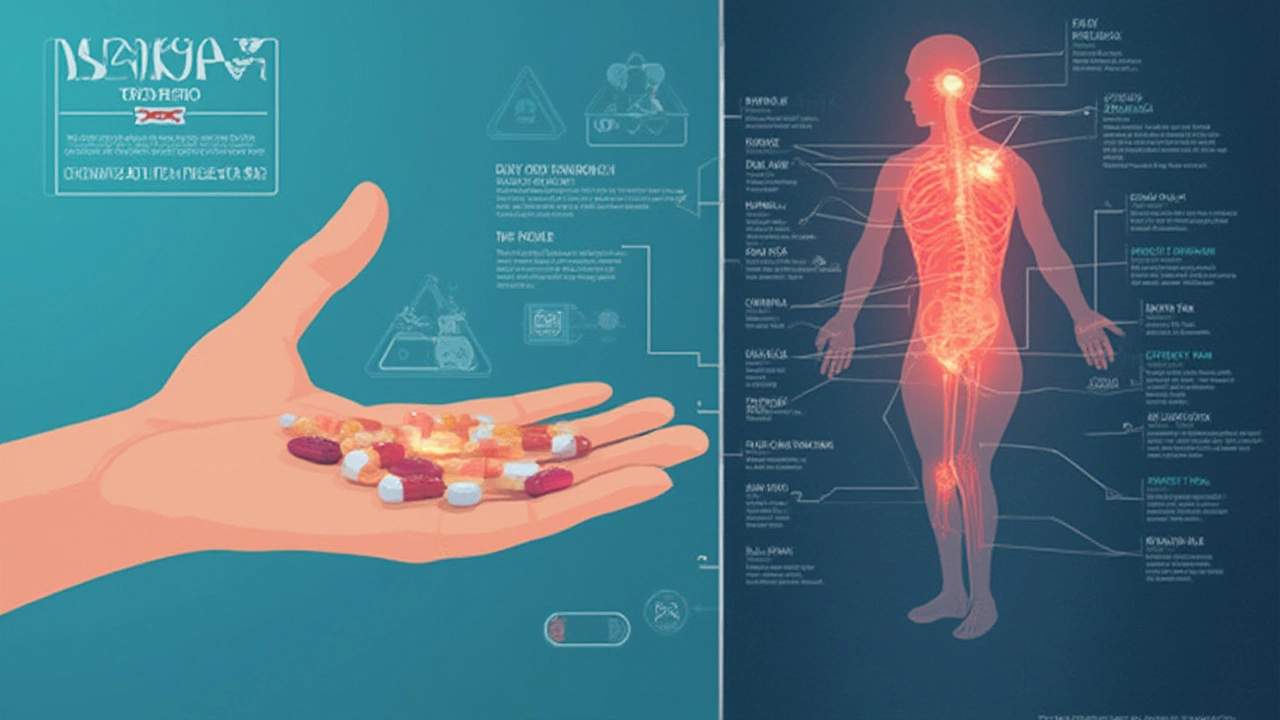Every morning, I hear the crackle of knees in my kitchen. Not from me—my oldest, Leonora, does the most dramatic stretches—but on some days I catch myself wincing from my own aches more than from her complaints. Chronic pain isn’t rare; it’s everyday life for millions. Yet shelves stacked with pain tablets leave most of us staring blankly. Which ones actually work for chronic pain?
What Does Chronic Pain Really Mean?
Chronic pain isn’t just about the keyword “chronic.” It sticks around for more than three months, sometimes hanging on long after the original injury or illness has healed. It could be aching joints, back pain that nags through the day, migraines, or nerve pain that zings in random patterns. Back in 2024, the British Pain Society estimated that 28 million adults in the UK alone lived with ongoing pain—that’s nearly half of the adult population. No wonder so many people end up popping painkillers before breakfast, after work, and before bed.
This kind of pain changes more than just your body. People lose sleep, snap at the kids (guilty), and see relationships strain under the daily tension. Chronic pain can mess with your mood, appetite, energy levels, and even your job. That means managing it isn’t just about numbing the hurt—it’s about keeping life moving.
Unlike acute pain (like a stubbed toe), chronic pain rarely has an off switch. That means popping a tablet here and there isn’t always enough. Medical advice always matters, especially before trying new meds or combining tablets. But what options actually show up on pharmacy shelves or get written as prescriptions?
Types of Pain Tablets and How They Work
The world of pain tablets is surprisingly crowded, even if most of us only recognize a handful. Here’s what’s usually offered up for chronic pain, and how they actually work inside your body.
- Paracetamol (Acetaminophen): The humble paracetamol gets recommended for just about everything. It doesn’t reduce swelling but can blunt mild to moderate pain by tweaking signals in the brain. It’s gentle on stomachs but overdosing can quietly damage the liver—one study in 2023 found it was responsible for half of acute liver failure admissions in UK hospitals.
- Non-steroidal Anti-inflammatory Drugs (NSAIDs): These include ibuprofen, naproxen, and diclofenac. NSAIDs block certain enzymes that cause inflammation, helping with joint pain, arthritis, or muscle sprains. They get the job done for swelling and stiffness, but they’re not risk-free; long-term use can upset your gut, raise blood pressure, and even hurt your kidneys.
- Opioids: Prescription-only tablets like codeine, tramadol, or morphine can flatten severe pain. Opioids work by binding to pain receptors in the brain and spinal cord, basically flipping off the pain switch. But there’s a big catch—dependence and the possibility of addiction rise quickly. As of 2024, the UK was trying to limit opioid prescriptions because of misuse and overdose risks. Long-term use can also make you more sensitive to pain, a cruel twist called opioid-induced hyperalgesia.
- Antidepressants: Some tablets, especially amitriptyline or duloxetine, help with pain that comes from nerves—think diabetic neuropathy or fibromyalgia. They change the way your brain processes pain, not just mood. You need a prescription, and side effects (drowsiness, dry mouth) show up, but for some, they’re a game changer.
- Anticonvulsants: Tablets like gabapentin or pregabalin, usually handed out for epilepsy, also help calm frazzled nerves in chronic pain. These need doctor supervision since side effects can include dizziness and swelling, but they’re often used for nerve pain from injuries or shingles.
- Topical NSAIDs and Lidocaine Patches: Technically not tablets, but patches and gels are worth mentioning. They deliver relief straight to sore spots—think diclofenac gel or lidocaine for localized nerve pain, with fewer whole-body side effects.
Here’s a quick cheat-sheet of pain tablets and their primary uses:
| Tablet Type | Example Names | Good For | Main Risks |
|---|---|---|---|
| Paracetamol | Panadol, Tylenol | Mild pain, headaches | Liver damage if overdosed |
| NSAIDs | Ibuprofen, Naproxen, Diclofenac | Inflammatory pain, arthritis | Stomach, kidney, heart risks |
| Opioids | Codeine, Tramadol, Morphine | Severe pain, cancer pain | Addiction, constipation, drowsiness |
| Antidepressants | Amitriptyline, Duloxetine | Nerve pain, fibromyalgia | Drowsiness, dry mouth |
| Anticonvulsants | Gabapentin, Pregabalin | Nerve pain, neuropathy | Dizziness, swelling |
| Topical NSAIDs | Diclofenac gel | Localized mild pain | Skin irritation |

Choosing the Right Tablet: What Really Works?
Here’s the blunt truth: One size doesn’t fit all. What finally helps your best friend’s painful knees might just make your back pain laugh. Still, a few real-world tips can help you land in the right aisle.
- If the pain is from inflammation—redness, swelling, warmth—start with an NSAID like ibuprofen or naproxen. Stick with the lowest dose for the shortest time. Stomach trouble or kidney issues? Ask your doctor first or try topical gels instead.
- For straightforward aches or fever (think mild back pain or tension headaches), paracetamol is a decent starter, but don’t double up with other cold meds packed with hidden paracetamol.
- If nerve pain keeps zapping (sharp, burning, shooting), prescription meds like amitriptyline, duloxetine, or pregabalin work better than basic painkillers. This often means chatting with a GP, as side effects require careful monitoring.
- Opioids are high-powered for severe or palliative pain—think post-surgery or cancer—not for the daily grind. In 2023, NHS guidance urged against long-term use for chronic pain, except as a last resort.
- If you pop a pain tablet every day, talk to your doctor at least once a year about kidney and liver function. Blood tests are simple and can spot trouble before you feel it.
There’s no “magic pill,” but many people find a mix of treatments works best. Some days you need an NSAID, other days an extra cushion and a heat pack. Friends swap tips, but listen to your own body. And, as parents discover, taking one painkiller for sore backs while chasing toddlers is different than managing migraines in teens.
One trick that’s helped in my house: tracking pain and tablets with a simple notebook. Write down the time, type, and any side effects. Gardeners, office workers, and fellow parents have told me they’ve spotted what works (and what doesn’t) much faster this way.
Risks, Hidden Pitfalls, and Smarter Choices
Most tablets aren’t as harmless as they seem. Even pharmacy basics can bounce back with nasty side effects if you take them too often or mix them without care. Here’s how the risks shake out in daily life:
- Taking ibuprofen every day can slowly nudge blood pressure up, which in turn pokes at your heart and kidneys. It also thins the stomach lining, leading to bleeding or ulcers—especially if you take aspirin or steroids too.
- Opioids require real caution. The UK saw 3,059 opioid-related deaths in 2023, and the number keeps nudging upward. Even short-term prescriptions come with constipation, foggy thinking, and the risk of tolerance—meaning you need higher doses for the same relief.
- Long-term paracetamol use isn’t perfectly safe, either. More than eight extra-strength tablets a day—or mixing multiple products with paracetamol—puts huge stress on your liver. In 2024, hospitals still see accidental overdoses from people doubling up unknowingly.
- Tiny tablets can also interact with food, alcohol, and other meds. Grapefruit can mess with some painkillers, and alcohol doubles the risks of tablets stressing your liver. Always check with a pharmacist if you’re not sure.
Here’s the honest advice doctors give their own families:
- Always read the patient information leaflet, even if you’ve taken the tablet before.
- Keep painkillers out of easy reach for kids. Accidental poisonings from “forgotten” paracetamol bottles still happen every week.
- Don’t crush or split tablets unless the packaging says it’s safe. Some meds lose effectiveness or turn risky when broken up the wrong way.
When tablets don’t work—or if side effects get worrying—it’s smart to ask for a medication review. Some patients benefit more from complementary approaches (acupuncture, gentle exercise, or physiotherapy) than endless tablets. The best pain management plans are as much about healthy sleep, movement, and stress control as they are about tablets. Sometimes, the right “tablet” is actually less medicine and more self-care mixed in.
The world of pain relief isn’t simple, and advertising rarely shows the full story. If you live with chronic pain, don’t settle for chasing symptom after symptom. Record your pain, be honest with your GP, and know that help can come in different forms—sometimes starting with the right tablet, but hopefully ending with much more than another pill bottle.
